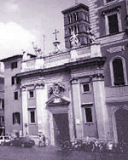HansUrs von Balthasar
MARY FOR TODAY
Original title: Maria fur haute 1987
Translator by Robert
Nowell
St. Paul Publications1988
3. The teacher of the
Church
What Mary wants throughout
the ages of the Church is not that we should venerate her as an
individual but that we should recognise the depth of God's
love in the work of his incarnation and redemption. Since
she lived in the house of the beloved disciple, it
would be astonishing if the gospel of the love of the triune God made manifest
in Christ had not been inspired also by her presence and what she had to say.
Certainly it is characteristic that the first apparition of Our Lady about' which
we learn from trustworthy sources is the vision of Origen's pupil Gregory the
Wonder-worker, recounted by Gregory of Nyssa, which
he had when preparing to be ordained as a bishop. While
one night he was pondering on the words of faith, a
form appeared to him, an old man in the attitude and dress of a priest, who
told him he would show him the divine wisdom in order to remove his uncertainty.
Then he gestured sideways with his hand and showed him another form
of more than human dignity and almost unbearable splendour. This said to John the Evangelist
that he should expound the mystery of faith to the young man, whereupon John said he would gladly comply with the wishes of the mother of the Lord, and explained the mystery of the Trinity to Gregory in clear words. Gregory wrote what was said down at once and later preached on this to the people (Patrologia graeca vol. 10 cols 984-988, vol. 46 cols 909-913). It is one of the finest and clearest credal formulae that we have.
Mary's concern
is also made clear in the words that Ephraem the Syrian put into her mouth as
an address to her son:
"While I gaze on your outward form which can be seen with physical eyes, my spirit comprehends
your hidden form. With my eyes I see the form of Adam, in your hidden form I see the Father dwelling in you. It is only to me that you have shown your glory in both forms. May the Church too, like your mother, see you both in your visible and in your mysterious form!"
It is
only in heaven that we shall appreciate how much the Church owes to Mary in understanding the faith, and indeed the "simple" much more than the "clever and wise". It would
thus be impossible to write a history of Mary's teaching through the centuries. But we can venture to say something about the sense and meaning of the apparitions of Our Lady that have been so many in recent times. Because Mary was so contemplative on earth, says Adrienne von Speyr, she can be so active in heaven, namely by letting the Church share in the superabundance of her memory. Simply by the fact that she shows herself she already leads us into the mystery of what the Church is in its essential nature: a pure work of God's grace. Mary is able, precisely in a spirit of complete humility, to point to herself because she is thereby pointing to nothing other than what God's almighty grace is capable of and at the same time what we should strive after in order to become proper vessels for this grace, in order to play the real role of the Church (as the body and bride of Christ) correctly in its mission of salvation for the world.
Again
and again in recent Marian apparitions the rosary has played a part: it has happened that Mary has fingered the beads along with those praying the rosary. Why should this be?
So that
we should prefer to pray to
her and
not to Christ or to the Father? On
the contrary, so
that it is from her
point of view, from her
memory that we
should look at the mysteries of Jesus's
life, and thereby at those of the trinitarian embodiment of salvation. Our eyes
are bleary and dull: if you will forgive the metaphor, we
must put on Mary's spectacles in order to see exactly.
"He who was scourged for our sake":
what this means only becomes to some extent
clear to us if we are aware of the effect
this scourging had on Mary's mind and heart. It is not
a question of a little bit of sympathy:
the weeping daughters of Jerusalem were
turned back on the way to the cross.
But his mother walked alongside unrecognised and
veiled, in complete strength and at the same time weakness: her heart is the true napkin of the legendary
Veronica. What Christ
is for her, what God is for her, becomes the primal and primary image of
what he should be for us, and this takes
place when in simplicity we try to look through her at the mysteries
of our redemption.
We are
forgetful. Things we have already heard
of too often fade in our memory. But
Mary's memory is throughout all these thousands of
years as fresh as on the first day. Let us let her appear daily before our eyes, as she may appear visibly to children she has chosen. There is no abyss between them and us. Rather it is as John the Evangelist says, that for living Christians faith
and knowledge are one. "We have believed, and have come to know, that
you are the Holy One of God" (In 6:69). "Now we know that you
know all things ... ; by this we believe
that you came from God" (In 16:30). Faith is the surrender
of the entire person: because Mary from the start surrendered everything,
her memory was the unsullied tablet on which the Father, through
the Spirit, could write his entire Word.
45






